
by Andrew Hanson
Conflux has been out for the better part of a month now, and as you read this, Pro Tour Kyoto is only one week away. The wait is killing me. I mean, I get excited/nervous at FNM when a whole bunch of new people show up. Imagine what the idea of actually competing in the Pro Tour is doing to me. I am constantly plagued by thoughts like, “what if I do well?” “What if I don't do well?” “What if I embarrass myself?” I'm determined to not let that happen. I'm determined to at the least come back with some good stories to share with all of you.
But today, I don't really have any good stories, so what I'm going to do is run through the ways I think Standard has been altered by Conflux, the way it has changed the big decks, and the way it may have altered the metagame. You know, all the stuff that's been going through my head for about a month as I tried to get ready for Kyoto.
We'll begin with a run-down of the power-house cards (in that, I mean the cards that will have the biggest impact on Standard), starting with the first one that made me sit up and take notice.
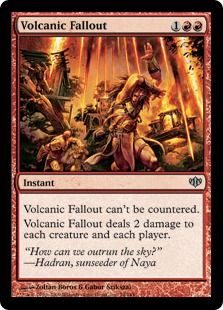
Mutavault, meet Fallout.
Play nice you two.
When I saw this bad boy, I didn't read it close enough. I just thought, “Oh, an uncounterable Pyroclasm for one extra ” (apparently, I think in mana symbols). Then, some friends asked me if I saw the Fallout in the spoiler.
“Oh, sure,” I said.
“That Pryoclasm that hits players, too.”
“It hits players?”
“Yeah,” they said. “And it's an instant.”
“Huh wha...?”
Of course, as soon as I got home, I looked the card up again. Wow. An instant-speed, uncounterable Clasm that hits players too. “This,” I thought, “is going to be big.” Why? Well, one hyphenated word. Man-lands. One of the biggest allures of the man-lands, the thing that really makes players look past the fact that they come into play tapped or only add colorless mana is that they dodge all modern board sweepers. Firespout, Wrath of God, Infest—none of them could kill a man-land without the land's controller doing something foolish and stupid (I've managed to get my Mutavault killed by a Wrath before).
But the Fallout doesn't have that problem. Which, perhaps more than any other board sweeper, makes multiples of them awesome. Pretend you're playing Monored Demigod, and you're up against Faeries. Bitterblossom has let your opponent build up quite the board, so you wait until he declares attackers, and then kill off his whole horde. Next turn, when he tries to get you with his Mutavaults and Faerie Conclaves, you just wait until after he declares attackers again, and boom, no more man-lands. Not to mention that you also just hit him for four points of uncounterable direct damage.
The Fallout does have one disadvantage to the similarly costed Firespout: it doesn't kill three-toughness kithkin. As most current Kithkin decks are running Glorious Anthems now (to deal with Infest), all their awesome two-toughness creatures (read: all the kithkin they play) are pumped out of Fallout range. You'd have to deal with the enchantment first to kill them, and we all know that red is the best color for enchantment removal.
But, I feel that the instant speed of the Fallout still makes it better than the Spout. Turn three, you can hold back your mana and watch the Monowhite Kithkin player (or the White/Red Kithkin Vengeant player). If they drop an Anthem, Fallout in response. If they drop, say, a Spectral Procession instead, say die at the end of turn. And on your next turn, drop that Boggart Ram-Gang you were holding and get there for three.
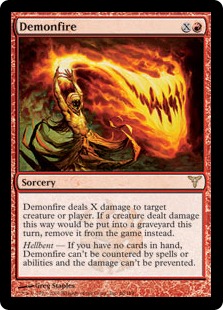
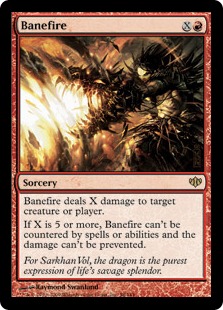
It's back!
The other card that will make a big splash for red players is an old favorite from Ravnica block: Banefire. “Wait!” you say, “Isn't Banefire a new card?” Oh fine, it is new. But the similarities to Dissension all-star Demonfire can't be ignored. Of course, back then, Demonfire had the Urza-tron (Urza's Mine, Urza's Power Plant, and Urza's Tower) to power it up to ridiculous levels of damage. There's nothing like that in Standard.
But it's not needed to make Banefire good. Look at the current aggro decks of Standard: Monored Demigod and the Kithkin decks. Both of them ramp up their curve, going from one-drops to five-drops, with a creature that likes it when they hit access to six colored mana. Six mana...what else could be done with six mana? Oh yeah! Hit someone in the dome with five uncounterable, unpreventable damage.
I don't play Monored or Faeries at FNMs, but I have friends that play both, and I watch this matchup whenever I can. The way it always seems to play out (barring total jank hands/draws) is that Monored beats Faeries down to a small life total (single digits is small when you're up against a red deck), then either loses the game to Faeries' excellent and expansive counter spell suite, or it draws more direct damage than Faeries draws counters, and it burns them out.
But what happens when Banefire gets added to the mix? As soon as Monored hits that magical sixth land, Banefire goes live. Even at ten life, Faeries is going to have issues—back to back Banefires ends them. Of course, back-to-back Banefires could be called the stone-cold nuts, in this case. But against the little bug men, Monored runs all four of the spell. And, of course, it runs the other new red spell, Volcanic Fallout. All four of them, too. That's eight uncounterable direct damage spells (it is unwise to not consider that the Fallout can be played like direct damage), with four of them sweeping the board of all but the Mistbind Clique. Seems pretty good against Faeries.
Here is the Monored Demigod deck my friends and I have been testing with since Conflux came out:
| Monored DemigodMagic OnlineOCTGN2ApprenticeBuy These Cards | ||
|---|---|---|
|
Lands 4 Ghitu Encampment 20 Mountain Creatures 4 Boggart Ram-Gang 4 Demigod of Revenge 4 Figure of Destiny 4 Mogg Fanatic 4 Stigma Lasher | Spells 2 Banefire 4 Flame Javelin 4 Incinerate 4 Magma Spray 2 Volcanic Fallout | Sideboard 2 Banefire 4 Everlasting Torment 4 Moonglove Extract 2 Volcanic Fallout 3 ??? |
At the time of this writing, we still have three open spots in the sideboard. Possible candidates are old sideboard card Unwilling Recruit or new color-hoser Ignite Disorder. The Everlasting Torments and the Moonglove Extracts are for kithkin, or rather for any deck running Burrenton Forge-Tender. Actually, let me be more clear: the Extracts are for the Forge-Tender. The Torments are for kithkin in general.
Like I said above, Glorious Anthem really screws up the effectiveness of Volcanic Fallout (so does Burrenton Forge-Tender). But with a Torment down, you don't need to worry about actually killing the creatures. All sources deal damage as though they had wither. That means all those x/3 creatures just fell to (x-2)/1, which is much more manageable. And, if you happen to rip another Fallout, or even an Ignite Disorder, you could finish the job. Of course, the Torment can be a double-edged sword. All your beefy guys that normally survive your board sweepers will be shrunk by them as well, so use with caution.
In practice, the deck comes out quickly, keeps up pressure with burn spells, and now has more finishers. Did it need more finishers? Not really, but having uncounterable spells was certainly high on red's wish-list, along with the reprinting of Flashfires and Anarchy. Thankfully, it didn't get the last two.
Path to Exile
Like many (most?), I saw this card on the MTGSalvation spoiler before Mike Flores previewed on Wizards of the Coast's website. He spent his whole article talking this card up, telling everyone how awesome it would be. He didn't say anything that everyone wasn't already thinking. This card is nuts.
My first reaction was that the spoiler had to be wrong. But then again, it was rarely wrong. So my next thought was, “How do I fit this into my deck?” That, I think, is a question a lot of deck-builders will be asking for the better part of the next two years. It gives Monowhite Kithkin something they've only been able to enjoy by spending on an Unmake. It gives Vengeant Kithkin a way to kill off Demigod of Revenge, Ashenmoor Gouger, or, and this is perhaps the best application, Mistbind Clique without having to dig for to get off a Flame Javelin. And, maybe not as relevant to most, but paramount to me, it gives Merfolk something they've never had before: instant-speed creature kill.
The majority of my testing has been against Faeries, and this card gives Merfolk game where it used to get pounded. Why? Mistbind Clique and lucky Loxodon Warhammer rips. On my turn four upkeep, before I could Cryptic Command, Faeries loves to drop a Mistbind Clique. Now, before they resolve the champion trigger, I can simply remove that fat faerie from the game.
Sure, they can still resolve the trigger and remove a faerie from the game (permanently, too, as the trigger to bring it back has come and gone with the death of the Clique), but they won't get the second trigger to tap my lands—the Mistbind Clique won't be in play to actually trigger off the champion. So rather than all my lands being tapped, only one land is. This is something the Kithkin variants get to do as well. Previously, Faeries really leaned on their ability to Time Walk via the Clique, but those days are looking numbered.
Like I said above, it can also kill Monored's fatties, including the Figure of Destiny. Of course, one needs to be careful about this. Faeries doesn't run many basics, and giving them one extra land for their turn five isn't too scary. Monored runs almost all basics, and giving them one extra mana means they could have a Demigod out a turn sooner, or a Banefire for five one turn sooner. The same concept applies to the Kithkin variants. Give them an extra land, and you may have a Cloud-Goat Ranger coming down one turn too soon. Oddly, the aggro decks of choice run more expensive cards than the control deck of choice...
Of course, all that doesn't mean that Path to Exile is bad against those decks, you just have to time it right. Taking out a Demigod while it's attacking is pretty awesome. Taking out a turn three Ashenmoor Gouger/Boggart Ram-Gang on your turn isn't. Even if the creature is going to be a major headache, at least wait until your opponent's turn to give them the extra land—it comes into play tapped, after all.
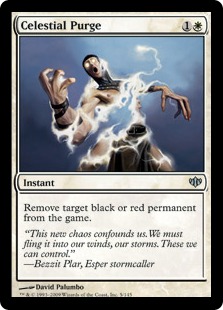
Path and this? Red is screwed.
I do sometimes wonder why this got printed. Did the developers over in Seattle fear that the tools they gave to red would make Monored decks too strong? It's not like white was hurting for anti-red cards (Burrenton Forge-Tender wrecks that entire color). Instead, as one friend pointed out, for perhaps the first time in the history of Magic, the monored aggro deck is a complete dog to the monowhite aggro deck. This card is only going to cement that position.
For one more mana than the Path was requiring, white can remove those annoying creatures (like Stigma Lasher, who screws up the tempo gained by Knight of Meadowgrain) without having to worry about accelerating the enemy into a big play. It kills Demigods and removes any worry about a second Demigod rip. And, this is what I think I like most about it, it can hit Everlasting Torment. Huh, wha?
Now, Everlasting Torment has not exactly been a metagame defining card. It hasn't had its name whispered among the tournament players for being sick, powerful, or even good. But I think it's Monored's only hope against the Kithkin decks. As mentioned above multiple times, Burrenton Forge-Tender ends red. And in the current decks, a sole Glorious Anthem turns off any two damage board sweeper. Monored's only recourse (other than adding a second color, and no longer being Monored) is this card. And white now has a tool to kill it as well—a tool that will never be dead even if the enchantment never gets played.
It can kill any permanent of those colors, including planeswalkers. That kind of versatility is hard to argue against.
Of course, after hosing red, the first thing I realized was that it can kill Bitterblossom. At first blush, that seems really good. But I've been thinking about it for some time now. What else does it kill from the Faeries deck? A Bitterblossom token? Is that it? Faeries adds black for kill spells and Bitterblossom, and nothing else. Yes, the Purge can kill the best enchantment in Standard, but if you're boarding it in against Faeries, you may get stuck with a potentially dead card. How much would it suck to top deck that when you're losing to a Mistbind Clique?
Does that mean it's useless against Faeries? I don't know. I honestly don't. I haven't boarded it in against Faeries with my Merfolk deck because with everything else I want in for that matchup, there's no room for it. Maybe Kithkin can squeeze it in against the Fae, though. I honestly don't know. But its inclusion in a sideboard I do know. If you're running white, some amount of this card should be in your fifteen.
Between the Purge and the Path, the Kithkin variants have two more awesome weapons to add to their arsenal. Here's a deck list that my friend playing Monowhite Kithkin is running:
| Monowhite KithkinMagic OnlineOCTGN2ApprenticeBuy These Cards | ||
|---|---|---|
|
Lands 20 Plains 4 Rustic Clachan Creatures 1 Burrenton Forge-Tender 4 Cloud-Goat Ranger 4 Figure of Destiny 4 Goldmeadow Stalwart 4 Knight of Meadowgrain 3 Ranger of Eos 4 Wizened Cenn | Spells 4 Glorious Anthem 4 Path to Exile 4 Spectral Procession | Sideboard 3 Burrenton Forge-Tender 4 Celestial Purge 2 Pollen Lullaby 1 Ranger of Eos 2 Reveillark 3 Runed Halo |
You may have noticed the lack of Windbrisk Heights. That's not a deck choice; we just don't have any Windbrisk Heights for him to run. If we had them, he'd run them. Whoops.
This deck has good game against Faeries, as it comes down fast with fat creatures (at least, creatures fatter than faeries), and with Spectral Procession, it can gum up the air, too. Faeries has a hard time countering the five and six converted mana cost spells that make multiple creatures—creatures that can be of respectable size if an Anthem is in play. And if an Anthem is in play, Infest becomes a much weaker card. My friend who plays Faeries at FNM says this is the one matchup he doesn't want to do. He'd rather play the mirror than go up against Monowhite Kithkin.
The Metagame
So how has all this shifted the metagame? Well, it's hard to say at the moment. Kyoto will be the definitive answer to that, but I have my suspicions based off some of the playtesting we've done. One of the first things I wanted to see (other than how Path to Exile changed Merfolk) was how Monored Demigod did with its new weapons against Faeries. Let me begin by saying Volcanic Fallout is the bomb. The bomb-diggity. The alpha to my omega. My own personal Jesus Christ. Okay, I don't know where I'm going with these metaphors anymore.
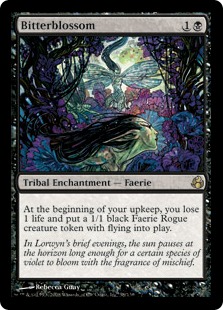
A total dog to the Fallout.
And it hits players. That part is nuts. Hits. Players. Think about how Monored plays. It whittles away at life with little things like Mogg Fanatics and Stigma Lashers, sometimes taking bigger chunks away with things like Ram-Gangs, all so it can finish off the opponent whose life is in the single digits with a big spell, like a Demigod. Against Faeries, those bigger chunks were harder to remove because of Bitterblossom-made chump-blocking tokens. And counter spells. Always counter spells.
But the days of Bitterblossom being an asset for Faeries against red may be over. Sure, they make a bunch of tokens. But then they all die, and the Faeries player takes two damage, to boot. Oh the whittling of life. Even if the Faeries player tries to champion the Blossom with a Mistbind Clique, Monored runs Flame Javelins. “No sir, put that Bitterblossom back on the board, take some more damage, and die to my Banefire.”
Banefire is also nuts. When you hit six lands, five life is the same as zero for your opponent. Nothing in Standard can save them (with one exception to be explained later). Faeries is doomed at that point. In the games I ran Monored against Faeries, I never saw a Banefire, but I didn't need it. In some of the other games I watched, I'd watch Faeries slowly stabilize the board while hovering around 10 life, then lose to back to back Banefires.
So does Faeries still have game? Of course. I don't think Faeries is ever without game. But it's matchup against Monored, which was always a little hard, is worse now. To the point that I believe Monored is the much favored. That, of course, will have some impact on the metagame. If Faeries, the king of Standard, has a low chance against a deck, won't that deck become the new king?
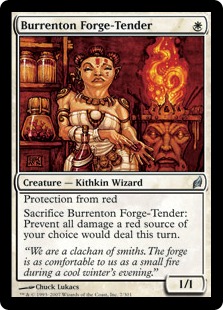
This card.
And he's not alone. Knight of Meadowgrain is also a giant pain in the neck for red. A first striker is never easy to deal with, as he neuters the effectiveness of Mogg Fanatics, and stops a Stigma Lasher cold. But he also has lifelink. How much does effective life gain hurt when your entire game plan is to trade card advantage for fast damage? Answer: a lot.
Then team up the other efficient drops that Monowhite Kithkin has, like the 2/2 for Goldmeadow Stalwart, the 2/2 psuedo-Crusade that is Wizened Cenn, and the creature advantage bomb of Spectral Procession, with universal pumper Glorious Anthem, and even a two-damage board-sweeper doesn't get the job done. Everything has a three toughness. And let's not even talk about how bad it gets when a second Anthem hits the board.
This comes back to what I said earlier about Everlasting Torment. At least, if red can't sweep the board, it can place a crap-load of -1/-1 counters everywhere. But look at the answer. A suboptimal card. It's not good, but it's all red has. That's why Monored won't become king of Standard. It loses to Kithkin. I've watched this matchup so many times, and it's just painful. Game one might be close, but games two and three are blowouts. Four Forge-Tenders with four Ranger of Eos means Monored can expect to go up against at least one of the pro-red 1/1s a game. Wait, did I say expect? I meant hope. Multiples are the norm, and Monowhite Kithkin can, with the help of a Knight of Meadowgrain, keep its life outside of Banefire kill range. Really, it's rarely ever a close game.
But how does Monowhite do against Faeries? This one is close. If Kithkin can hit its curve right, dropping a Stalwart on one, a Knight on two, and a Procession on three, Faeries has issues. Especially if Monowhite is holding an Anthem, and just waiting for Faeries to tap lands to answer the other threats. The 2/2 spirit tokens blow out the Bitterblossom tokens.
But, that's Monowhite having the nuts hand. If they don't have that, it's a much harder game for them.

It beats Anthem. Hell, it beats everything.
After watching this matchup a lot, I would say that Faeries is the favored. Not by so much as to say that Monowhite has no chance, or that it's even a bad choice, but Faeries is the favored. Which sort of makes a Rock-Scissors-Paper scenario in Standard. Monored beats Faeries, Monowhite beats Monored, Faeries beats Monowhite. Of course, this is a simplistic way to look at it and doesn't take other really good decks into account. Decks like Vengeant Lark, or Black/White Tokens. But in the end, I foresee the concentration of decks played in the metagame to shift.
Faeries' matchup against Monored is bad enough to warrant some people abandoning other decks to use the color of burn, while some might actually abandon the Fae for something more fire-retardent. And as Monored is such a dog to Monowhite, those that give up the Fae will probably go there. It did receive Path to Exile after all, and who wouldn't want to play with Swords Junior? I think, and this is what I'm planning for, Monowhite Kithkin (and the other Kithkin derivatives) will be the most played in Kyoto, followed by Faeries, followed by Monored.
Monowhite's matchup is so good against red, and its Faeries matchup isn't bad, that I think it may be the best deck out of the three right now. Faeries is close though. It's matchup against Kithkin is good, but it's matchup against Monored is nearing awful, which is enough to say that Monowhite, which has no awful matchups, is a better choice.
That brings us to what I will play in Kyoto. Well, this will be no surprise to most, and some may say I'm just running it because it's a pet-deck. But, truthfully, I have seriously considered dropping it, especially considering the advice some of the better players at FNM have been giving. But the reason I think I will run it, is that it actually pigeon-holes the metagame I'm predicting. The deck? Merfolk.
| my Merfolk deckMagic OnlineOCTGN2ApprenticeBuy These Cards | ||
|---|---|---|
|
Land 4 Adarkar Wastes 4 Faerie Conclave 3 Island 4 Mutavault 4 Mystic Gate 1 Plains 4 Wanderwine Hub Creatures 4 Deft Duelist 4 Merrow Reejerey 4 Silvergill Adept 4 Sower of Temptation 4 Stonybrook Banneret 4 Sygg, River Guide 4 Wake Thrasher | Spells 4 Cryptic Command 4 Path to Exile | Sideboard 4 Burrenton Forge-Tender 4 Pollen Lullaby 4 Reveillark 3 Runed Halo |
I sort of lied when I said Monowhite Kithkin has no awful matchups. This may be the one. I play like an aggro deck, running creatures out almost as fast as the Kithkin, then win using faux-Time Walk, and probably strongest card in Standard, Cryptic Command to steal a game they would have won. Of course, I do have to see the blue card to pull this off. That's why I also run four of the better-than-Holy Day Pollen Lullaby. It functions like Cryptic Command five-eight, and it's cheaper, too.
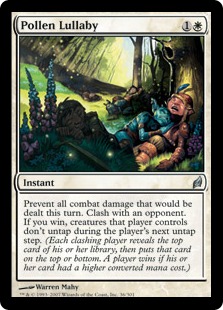
It may look like crap, but it's legit.
The deck's game against the Demigod decks is also really good. Game one, my win percentage isn't so hot, probably under 50%. No, not probably. Certainly under 50%. But post-board...I'm playing Blue/White, which means I have access to Mr. Anti-Red himself, as well as sick card advantage in Reveillark. The deck's win rate goes way up, probably around 70-80%. Forge-Tender is that good, especially when you can recur him with the Lark.
Initial playtesting with the new cards did show me I have to be a bit more careful. A shrewd opponent will kill off the Lark, then Fallout the board, making me choose between my Forge-Tender or my resurrected creatures, which means I have to protect my Lark more than usual. And Banefire is a house against me. Just like Faeries, when Merfolk gets to 10 life, all it takes is back to back Banefires to end it (not that unusual when Monored boards in Banefires three and four). That's what the Runed Halos are for. Sure, Banefire may not be countered or prevented, but if I have protection from it, I can't be targeted by it in the first place. And it's not like seeing multiple Runed Halos against red is bad—the second and third one can call out Demigod or Flame Javelin or even Ghitu Encampment.
It's Merfolk's game against Faeries that I don't like. It's under 50%. Certainly, maindecking the Deft Duelists has increased that number pre-board, and Path to Exile gives it better game all-around. But I don't think Merfolk has a chance if Faeries sees the nuts hand. Of course, not many decks do. In fact, being able to beat the Faeries nuts may be unique to Monored.
The matchup isn't unwinnable for Merfolk, though, just hard. However, I don't think it will be any harder than, say, the Faerie mirror match against Paulo Vitor Damo Da Rosa. Or against any pro player. Or against any semi-pro player who's been playing Faeries for a while. And besides, the whole reason I am running Merfolk is that I think Faeries may show up in less numbers than at Worlds, that Faeries may in fact be a suboptimal metagame choice.
Of course, if I'm wrong, my first Pro Tour experience could be pretty grim. Here's to hoping I'm not wrong. Wish me luck!
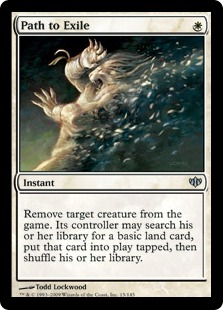
Comments